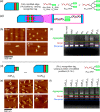Fluorous-Directed Assembly of DNA Origami Nanostructures
- PMID: 36537902
- PMCID: PMC9835977
- DOI: 10.1021/acsnano.2c10727
Fluorous-Directed Assembly of DNA Origami Nanostructures
Abstract
An orthogonal, noncovalent approach to direct the assembly of higher-order DNA origami nanostructures is described. By incorporating perfluorinated tags into the edges of DNA origami tiles we control their hierarchical assembly via fluorous-directed recognition. When we combine this approach with Watson-Crick base-pairing we form discrete dimeric constructs in significantly higher yield (8x) than when either molecular recognition method is used in isolation. This integrated "catch-and-latch" approach, which combines the strength and mobility of the fluorous effect with the specificity of base-pairing, provides an additional toolset for DNA nanotechnology, one that enables increased assembly efficiency while requiring significantly fewer DNA sequences. As a result, our integration of fluorous-directed assembly into origami systems represents a cheap, atom-efficient means to produce discrete superstructures.
Keywords: DNA nanotechnology; DNA origami; DNA origami dimerization; fluorous; fluorous DNA; molecular recognition; self-assembly.
Conflict of interest statement
The authors declare no competing financial interest.
Figures





References
Publication types
MeSH terms
Substances
Grants and funding
LinkOut - more resources
Full Text Sources
Research Materials

